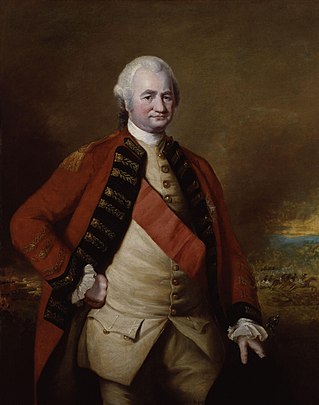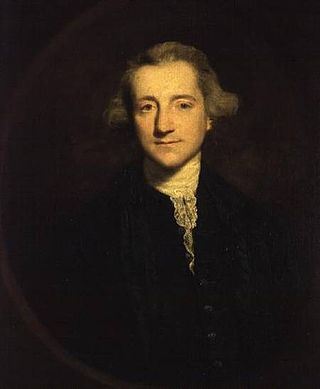Related Research Articles

Robert Clive, 1st Baron Clive,, also known as Clive of India, was the first British Governor of the Bengal Presidency. Clive has been widely credited for laying the foundation of the British East India Company (EIC) rule in Bengal. He began as a writer for the EIC in 1744 and established Company rule in Bengal by winning the Battle of Plassey in 1757. In return for supporting the Nawab Mir Jafar as ruler of Bengal, Clive was guaranteed a jagir of £30,000 per year which was the rent the EIC would otherwise pay to the Nawab for their tax-farming concession. When Clive left India in January 1767 he had a fortune of £180,000 which he remitted through the Dutch East India Company.

Lieutenant-General Sir Eyre Coote, KB was an Anglo-Irish military officer and politician who sat in the House of Commons from 1768 to 1780. He is best known for his many years of service with the British Army in India. His victory at the Battle of Wandiwash is considered a decisive turning point in the struggle for control in India between Britain and France. He was known by his sepoy troops as Coote Bahadur.

The Battle of Plassey was a decisive victory of the British East India Company, under the leadership of Robert Clive, over the Nawab of Bengal and his French allies on 23 June 1757. Robert Clive was paid £1 million by the Jagat Seth family – a rich Indian family business group – to defeat Siraj-ud-Daulah. The victory was made possible by the defection of Mir Jafar, Nawab Siraj-ud-Daulah's commander in chief who was also paid by the Jagat Seths. The battle helped the British East India Company take control of Bengal in 1772. Over the next hundred years, they continued to expand their control over vast territories in the rest of the Indian subcontinent, including Burma.
The 102nd Regiment of Foot was a regiment of the British Army raised by the Honourable East India Company in 1742. It transferred to the command of the British Army in 1862. Under the Childers Reforms it amalgamated with the 103rd Regiment of Foot in 1881 to form the Royal Dublin Fusiliers.

Sir George Nugent, 1st Baronet, GCB was a British Army officer. After serving as a junior officer in the American Revolutionary War, he fought with the Coldstream Guards under the Duke of York during the Flanders Campaign. He then commanded the Buckinghamshire Volunteers in the actions of St. Andria and Thuyl on the river Waal and participated in the disastrous retreat from the Rhine. He went on to be commander of the northern district of Ireland, in which post he played an important part in placating the people of Belfast during the Irish Rebellion, and then became Adjutant-General in Ireland. He went on to be Governor of Jamaica, commander of the Western District in England, commander of the Kent District in England and finally Commander-in-Chief, India.

Henry Vansittart was an English colonial administrator, who was the Governor of Bengal from 1759 to 1764.

General Sir Abraham Roberts was a British East India Company Army general who served nearly 50 years in India.

The Battle of Sobraon was fought on 10 February 1846, between the forces of the East India Company and the Sikh Khalsa Army, the army of the declining Sikh Empire of the Punjab. The Sikhs were completely defeated, making this the decisive battle of the First Anglo-Sikh War.

Seaforde is a small village in County Down, Northern Ireland. It is within the townland of Naghan, one mile (1.6 km) north of Clough on the main Ballynahinch to Newcastle road. It is part of the Newry, Mourne and Down area.
The 37th Regiment of Foot was a line infantry regiment of the British Army, raised in Ireland in February 1702. Under the Childers Reforms it amalgamated with the 67th Regiment of Foot to become the Hampshire Regiment in 1881.

The 39th (Dorsetshire) Regiment of Foot was an infantry regiment of the British Army, raised in 1702. Under the Childers Reforms it amalgamated with the 54th Regiment of Foot to form the Dorsetshire Regiment in 1881.
Brigadier-General John Carnac was a British officer who served three times as Commander-in-Chief of India. The son of Capt. Peter Carnac (1665–1756), and Andrienne, née Lelonte, he was baptised in London.
The 101st Regiment of Foot (Royal Bengal Fusiliers) was an infantry regiment of the Bengal Army and British Army that existed from 1652 to 1881. The regiment was raised in India in 1652 by the East India Company as the company's first non-native infantry regiment. Over the following two centuries, the regiment was involved in nearly all of the East India Company's conflicts which consolidated British rule over India. The Royal Bengal Fusiliers was transferred to the command of the British Army in 1862 following the Indian Mutiny of 1857 and the end of Company rule in India. Under the Childers Reforms it amalgamated with the 104th Regiment of Foot (Bengal Fusiliers) to form the Royal Munster Fusiliers in 1881.
The 104th Regiment of Foot was a regiment of the British Army, raised by the Honourable East India Company in 1765. Under the Childers Reforms it amalgamated with the 101st Regiment of Foot to form the Royal Munster Fusiliers.

Lieutenant-General Sir John James Hamilton, 1st Baronet was a British officer of the Honourable East India Company, the British Army and during the Napoleonic Wars the Portuguese Army who saw action across the world from India to the West Indies and was honoured for his service by both the British and Portuguese royal families. Of noble Irish descent, related by birth to the first Earl Castle Stewart and by marriage to the Earl of Tyrone, Hamilton's extensive career and brave service was widely recognised during his life and after his death.

The regiments of Bengal Native Infantry, alongside the regiments of Bengal European Infantry, were the regular infantry components of the East India Company's Bengal Army from the raising of the first Native battalion in 1757 to the passing into law of the Government of India Act 1858. At this latter point control of the East India Company's Bengal Presidency passed to the British Government. The first locally recruited battalion was raised by the East India Company in 1757 and by the start of 1857 there were 74 regiments of Bengal Native Infantry in the Bengal Army. Following the Mutiny the Presidency armies came under the direct control of the United Kingdom Government and there was a widespread reorganisation of the Bengal Army that saw the Bengal Native Infantry regiments reduced to 45.

The Battle of Chinsurah, also known as the Battle of Biderra or the Battle of Hoogly, was a military engagement which took place on 25 November 1759 near Chinsurah during the Seven Years' War. It took place between a force of British troops mainly of the British East India Company and a force of the Dutch East India Company which had been invited by the Nawab of Bengal Mir Jafar to help him expel the British and establish themselves as the leading commercial company in Bengal.
Brigadier-General Sir Robert Barker, 1st Baronet, FRS was a British Army officer who served in the Seven Years' War and politician who sat in the House of Commons from 1774 to 1780. He served as Commander-in-Chief, India between 1770 and 1773.
Sir Henry Thomas Godwin KCB (1784–1853) was a British officer. He fought in the British Army in the Peninsular War and in the First Anglo-Burmese War before joining the Bengal Army, in which he served as commander in chief of British and Indian forces in the Second Anglo-Burmese War of 1852 and 1853.

Lieutenant-Colonel William Collis Spring was an Anglo-Irish British Army officer of the Napoleonic Wars.
References
- ↑ Harvey p.237
- ↑ Oxford Dictionary of National Biography, Volume 20. Oxford University Press. 2004. p. 350. ISBN 0-19-861370-9.Article by H M Stephens, revised by D J Prior.